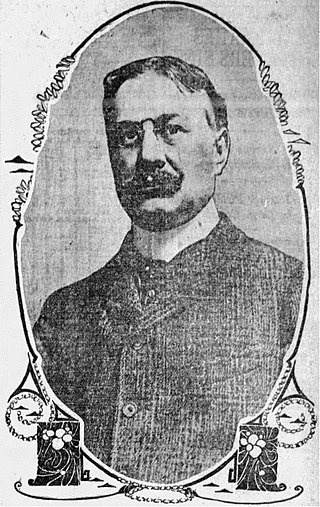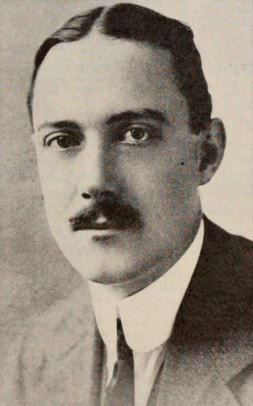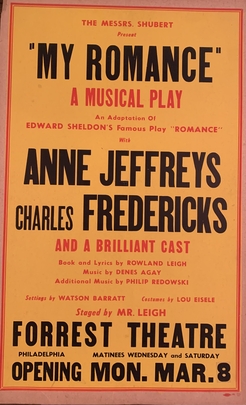Related Research Articles
Mam'zelle Champagne was a musical revue set in Paris with book by Edgar Allan Woolf, music by Cassius Freeborn, produced by Henry Pincus, which opened June 25, 1906. On opening night at the outdoor Madison Square Garden Roof Theatre, millionaire playboy Harry K. Thaw shot and killed architect Stanford White: the otherwise undistinguished musical's run continued for some 60 performances largely on the publicity from this incident.

Gustave Adolph Kerker, sometimes given as Gustav or Gustavus Kerker, was a German-born composer and conductor who spent most of his life in the United States. He became a musical director for Broadway theatre productions and wrote the music for a series of operettas and musicals produced on Broadway and in the West End. His most famous musical was The Belle of New York (1897).

The Wizard of the Nile is a comic opera in three acts with music by composer Victor Herbert and a libretto by Harry B. Smith. This was Herbert's second comic opera after Prince Ananias, and was his first real success.
In Gay New York is a musical revue with a script by C. M. S. McLellan, under his pseudonym Hugh Morton, and music by Gustave Kerker. The story revolves around two newlyweds from Maine who come to New York City, do some sightseeing, and see bits from the 1895–96 season at the Casino satirized in vaudevillian action.

The Midnight Sons is a 1909 American musical comedy that was popular upon its release.
The Red Petticoat is a 1912 musical-comedy in 3 acts with book and lyrics by Rida Johnson Young and Paul West, music by Jerome Kern, and directed by Joseph W. Herbert. Set in the fictional town of Lost River, Nevada, the Western-genre musical starred Helen Lowell as tough lady barber Sophie Brush in the rough silver-mining town of Lost River, Nevada, who gets her man. Songs included "I Wonder", "My Peaches and Cream", "Oh You Beautiful Spring", "The Ragtime Restaurant", and "Since the Days of Grandmamma". The musical was based on a 1911 farcical melodrama by Young titled Next!. It was Kern's first complete score.
Max Freeman was a German actor, theater director, theater manager, playwright, and producer who was primarily active in the United States. After beginning his career in his native city of Berlin in 1868, Freeman eventually moved to the United States in 1871 where he began his career in America as the theatre manager for the Germania Theatre in New York City. He had a lengthy stage career as an actor in America from 1873 until his death in 1912. Known as the "godfather of comic opera", he particularly excelled in performances in roles from light operas and musical comedies, and was also responsible for directing and producing works from this genre on Broadway. He also directed and played parts in straight plays as well. His adaptation of Jacques Offenbach's Orfée aux enfers was performed for the grand opening of Broadway's Bijou Theatre in 1883, and his original musical play Claudius Nero, based on Ernest Erkstein's novel Nero, premiered at Niblo's Garden in 1890.

Jerome Sykes was an American stage actor, singer and comedian. He was perhaps best known for his performances as Foxy Quiller in two theatrical productions. His brother Albert S Sykes was also an actor.

Mary Arnaud "May" Naudain was an American musical theatre actress and singer.

John Goldsworthy (1884–1958) was a British-born stage and film actor. After emigrating to the United States he was active on Broadway appearing in a variety of plays, as well as several musicals. During the silent era he appeared in supporting roles in American films. Later in the 1940s he returned to the cinema, now playing mainly small, uncredited parts. His final film was MGM's The Prisoner of Zenda (1952).

Look, Ma, I'm Dancin’! is a musical comedy in two acts with a book by Jerome Lawrence and Robert E. Lee, and music and lyrics by Hugh Martin. It was produced on Broadway in 1948.

My Romance is a musical comedy in three acts with book and lyrics by Rowland Leigh, and music by Sigmund Romberg. It was produced on Broadway in 1948.

Along Fifth Avenue is a revue in two acts with sketches by Charles Sherman and Nat Hiken; music by Gordon Jenkins, Richard Stutz, Milton Pascal and Hiken; and lyrics by Tom Adair, Stutz, Pascal and Hiken. It was produced on Broadway in 1949.
Louis De Lange, also known as Louis De Lange Moss was an American playwright, actor, and theatrical manager. As a stage actor he primarily appeared in light operas and musicals; notably portraying Sir Joseph Porter in the original production of John Philip Sousa's pirated version of Gilbert and Sullivan's H.M.S. Pinafore in Philadelphia, on Broadway and on tour in 1879. As a dramatist he mainly wrote the books for musicals; often in collaboration with writer Edgar Smith on projects created for the comedy duo Lew Fields and Joe Weber. De Lange also worked as Fields and Weber's manager for their national tours. His wife was the Broadway actress Selma Mantell who appeared in the Ziegfeld Follies among other Broadway shows. Their son was the bandleader and lyricist Eddie DeLange.
Frederick J. Eustis, sometime referred to as F. J. Eustis, was an American composer, conductor, and theatre director. He is best remembered for writing music for several Broadway musicals.

Louis Harrison was an actor, playwright, comedian, lyricist, librettist, and theatre director. As both a performer and playwright, he was mainly active within the genres of musical theatre and light opera.
Ernest Albert, born Ernest Albert Brown, was an American painter, illustrator, muralist, and scenic designer. He was a prolific scenic designer, first in Saint Louis and Chicago and then on Broadway. He is considered a major American landscape painter and was elected the first president of the Allied Artists of America in 1919.
Jack O'Lantern is a musical in two acts and 8 scenes with music by Ivan Caryll and both lyrics and book co-authored by Anne Caldwell and R. H. Burnside. The work also included some additional songs with music by Irving Berlin, Shelton Brooks and Gus King; and lyrics by Louis Harrison and Benjamin Hapgood Burt.
The Man in the Moon is a musical in three acts with music by composers Ludwig Engländer, Gustav Kerker, and Reginald De Koven; and both book and lyrics by Louis Harrison and Stanislaus Strange. The work premiered on Broadway at the New York Theatre on April 24, 1899. The production closed after 192 performances on November 4, 1899. Produced and directed by George W. Lederer, the show used choreography by Carl Marwig, costumes by Caroline Siedle, and sets created by D. Frank Dodge, Henry E. Hoyt, St. John Lewis and Ernest Albert. The cast included Sam Bernard as Conan Doyle, Marie Dressler as Viola Alum, and Christie MacDonald as Diana.
The Errand Boy is a musical in two acts with lyrics by Edward P. Moore and a book by George Totten Smith. Created as a starring vehicle for vaudeville star Billy B. Van, the composer of the music for this work was never credited. Set in the town of Georges Mills, New Hampshire, the plot centers around the local errand boy Patsy Bolivar who becomes involved with a troupe of traveling performers stranded in his town.
References
- ↑ Letellier, p. 1027
- ↑ Franceschina, p. 144
- 1 2 Bordman & Norton, p. 219
- ↑ Mantle, Sherwood & Chapman, p. 425
- 1 2 Dietz, p. 137-138
- ↑ "JEROME SYKES IS DEAD, Comic Opera Star a Victim of Pneumonia". The Topeka State Journal . December 30, 1903.